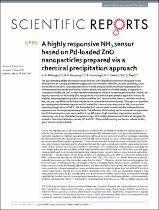 ResearchSpace
ResearchSpace
A highly responsive NH3 sensor based on Pd-loaded ZnO nanoparticles prepared via a chemical precipitation approach
JavaScript is disabled for your browser. Some features of this site may not work without it.
- ResearchSpace
- →
- Research Publications/Outputs
- →
- Journal Articles
- →
- View Item
| dc.contributor.author |
Mhlongo, Gugu H

|
|
| dc.contributor.author |
Motaung, David E

|
|
| dc.contributor.author |
Cummings, FR

|
|
| dc.contributor.author |
Swart, HC

|
|
| dc.contributor.author |
Ray, Suprakas S

|
|
| dc.date.accessioned | 2019-10-14T07:58:01Z | |
| dc.date.available | 2019-10-14T07:58:01Z | |
| dc.date.issued | 2019-07 | |
| dc.identifier.citation | Mhlongo, G.H., Motaung, D.E., Cummings, F.R., Swart, H.C. & Ray, S.S. 2019. A highly responsive NH3 sensor based on Pd-loaded ZnO nanoparticles prepared via a chemical precipitation approach. Scientific Reports, vol 9, pp. 1-18 | en_US |
| dc.identifier.issn | 2045-2322 | |
| dc.identifier.uri | https://doi.org/10.1038/s41598-019-46247-z | |
| dc.identifier.uri | https://www.nature.com/articles/s41598-019-46247-z | |
| dc.identifier.uri | http://hdl.handle.net/10204/11166 | |
| dc.description | This article is licensed under a Creative Commons Attribution 4.0 International License, which permits use, sharing, adaptation, distribution and reproduction in any medium or format, as long as you give appropriate credit to the original author(s) and the source, provide a link to the Creative Commons license, and indicate if changes were made. | en_US |
| dc.description.abstract | The gas-detecting ability of nanostructured ZnO has led to significant attention being paid to the development of a unique and effective approach to its synthesis. However, its poor sensitivity, cross-sensitivity to humidity, long response/recovery times and poor selectivity hinder its practical use in environmental and health monitoring. In this context, the addition of noble metals, as dopants or catalysts to modify the ZnO surface has been examined to enhance its sensing performance. Herein, we report preparation of Pd-loaded ZnO nanoparticles via a chemical precipitation approach. Various Pd loadings were employed to produce surface-modified ZnO nanostructure sensors, and their resulting NH3 sensing capabilities both in dry and humid environments were investigated. Through a comparative gas sensing study between the pure and Pd-loaded ZnO sensors upon exposure to NH3 at an optimal operating temperature of 350 °C, the Pd-loaded ZnO sensors were found to exhibit enhanced sensor responses and fast response/recovery times. The influence of Pd loading and its successful incorporation into ZnO nanostructure was examined by X-ray diffraction, high resolution-transmission electron microscopy, and X-ray photoelectron spectroscopy. XPS studies demonstrated that in all samples, Pd existed in two chemical states, namely Pd° and Pd2+. The possible sensing mechanism related to NH3 gas is also discussed in detail. | en_US |
| dc.language.iso | en | en_US |
| dc.publisher | Springer Nature Publishing AG | en_US |
| dc.relation.ispartofseries | Workflow;22612 | |
| dc.subject | Chemical precipitation | en_US |
| dc.subject | Nanostructured ZnO | en_US |
| dc.subject | ZnO surface | en_US |
| dc.title | A highly responsive NH3 sensor based on Pd-loaded ZnO nanoparticles prepared via a chemical precipitation approach | en_US |
| dc.type | Article | en_US |
| dc.identifier.apacitation | Mhlongo, G. H., Motaung, D. E., Cummings, F., Swart, H., & Ray, S. S. (2019). A highly responsive NH3 sensor based on Pd-loaded ZnO nanoparticles prepared via a chemical precipitation approach. http://hdl.handle.net/10204/11166 | en_ZA |
| dc.identifier.chicagocitation | Mhlongo, Gugu H, David E Motaung, FR Cummings, HC Swart, and Suprakas S Ray "A highly responsive NH3 sensor based on Pd-loaded ZnO nanoparticles prepared via a chemical precipitation approach." (2019) http://hdl.handle.net/10204/11166 | en_ZA |
| dc.identifier.vancouvercitation | Mhlongo GH, Motaung DE, Cummings F, Swart H, Ray SS. A highly responsive NH3 sensor based on Pd-loaded ZnO nanoparticles prepared via a chemical precipitation approach. 2019; http://hdl.handle.net/10204/11166. | en_ZA |
| dc.identifier.ris | TY - Article AU - Mhlongo, Gugu H AU - Motaung, David E AU - Cummings, FR AU - Swart, HC AU - Ray, Suprakas S AB - The gas-detecting ability of nanostructured ZnO has led to significant attention being paid to the development of a unique and effective approach to its synthesis. However, its poor sensitivity, cross-sensitivity to humidity, long response/recovery times and poor selectivity hinder its practical use in environmental and health monitoring. In this context, the addition of noble metals, as dopants or catalysts to modify the ZnO surface has been examined to enhance its sensing performance. Herein, we report preparation of Pd-loaded ZnO nanoparticles via a chemical precipitation approach. Various Pd loadings were employed to produce surface-modified ZnO nanostructure sensors, and their resulting NH3 sensing capabilities both in dry and humid environments were investigated. Through a comparative gas sensing study between the pure and Pd-loaded ZnO sensors upon exposure to NH3 at an optimal operating temperature of 350 °C, the Pd-loaded ZnO sensors were found to exhibit enhanced sensor responses and fast response/recovery times. The influence of Pd loading and its successful incorporation into ZnO nanostructure was examined by X-ray diffraction, high resolution-transmission electron microscopy, and X-ray photoelectron spectroscopy. XPS studies demonstrated that in all samples, Pd existed in two chemical states, namely Pd° and Pd2+. The possible sensing mechanism related to NH3 gas is also discussed in detail. DA - 2019-07 DB - ResearchSpace DP - CSIR KW - Chemical precipitation KW - Nanostructured ZnO KW - ZnO surface LK - https://researchspace.csir.co.za PY - 2019 SM - 2045-2322 T1 - A highly responsive NH3 sensor based on Pd-loaded ZnO nanoparticles prepared via a chemical precipitation approach TI - A highly responsive NH3 sensor based on Pd-loaded ZnO nanoparticles prepared via a chemical precipitation approach UR - http://hdl.handle.net/10204/11166 ER - | en_ZA |





